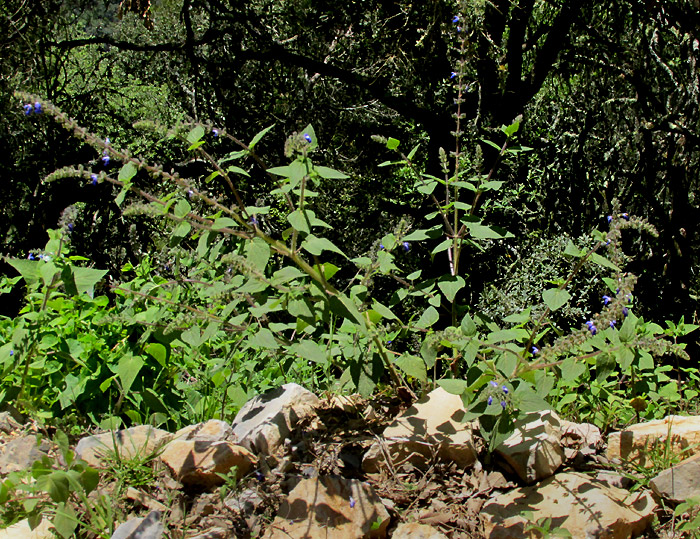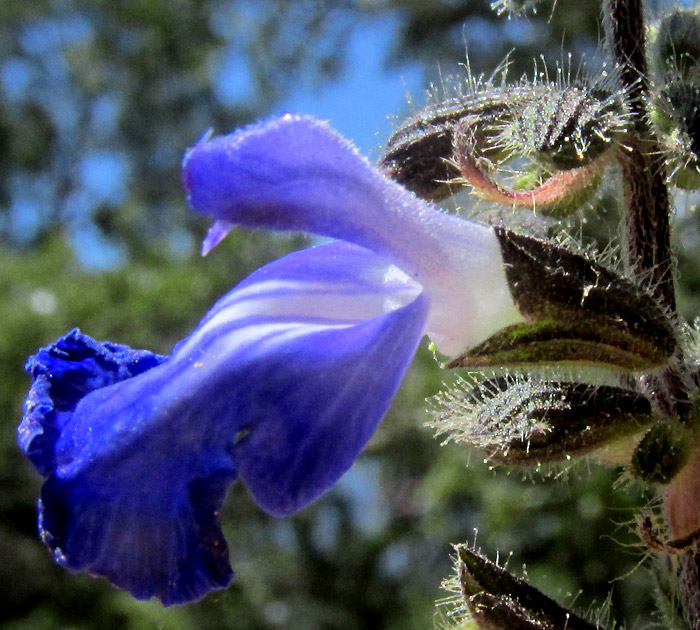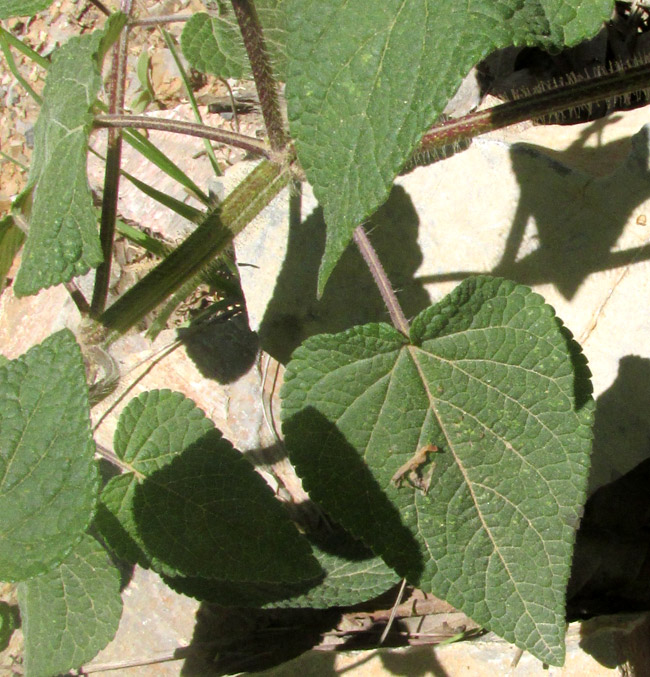Excerpts from Jim Conrad's
Naturalist Newsletter
Entry from field notes dated September 3, 2023, taken in Los Mármoles National Park in the Eastern Sierra Madre mountains, Hidalgo state, MÉXICO; oak-pine forested mountain, on road leading to Puerto de Piedra, which branches off the road between Trancas {on maps designated "Morelos (Trancas)"} and Nicolás Flores; limestone bedrock; elevation ~2,550m (~8,350); N20.811°, W99.219°
GRAPE-SCENTED SAGE

At the gravel road's edge, the above spreading, lanky, semiwoody-stemmed, hip-high shrub was flourishing despite the area's ongoing, severe, two-year drought. Seeing small, blue flowers arranged in few-flowered whorls widely separated in slender inflorescences topping the stems, which bore pairs of leaves opposite one another at each stem node, already it looked like yet another sage, of the big, complex genus Salvia, of the Mint Family, the Lamiaceae. Looking closely into a blossom's mouth confirmed it:

The corolla was strongly bilaterally symmetrical, a large landing pad spread out at the bottom for pollinators, and at the top the monk-hood wrapped over two stamens. Each stamen's filament bore a special lever mechanism causing anthers to bend down and daub pollen atop bees pushing themselves toward nectar nirvana. That was all pure Salvia. However, so far nothing seen distinguished our roadside plant from other sages we've seen, except for this:

The calyxes were exceptionally long-hairy, and most hairs were tipped with glistening glands. The "stalked glands" were something special.

Broad-based, wrinkly leaf blades were attached to long petioles, much like the blue-flowered Salvia keerlii. However, that look-alike species doesn't produce such spectacular stalked glands on its calyxes.
In our part of upland central Mexico, if you have a blue-flowered Salvia with such broad-based, wrinkly leaves and the flowers' calyxes are covered with long, gland-tipped hairs, you have SALVIA MELISSODORA, often known as the Grape-scented Sage.
Our plant bears an English name because up north it's sold as "a graceful, upright, shrubby sage with a pleasing scent." I detected a pleasant odor but I'd never have thought of grapes. The species is distributed over the same general area, and in the same habitats, as the earlier mentioned lookalike, Salvia keerlii; it occurs from northern Mexico south to Oaxaca, except Baja, and likes semiarid scrub as well as forests dominated by junipers and oak-pines. One wonders if the two species might end up as two varieties of one species, the stalked glands making the difference.
The online Biblioteca Digital de la Medicina Tradicional Mexicana, which calls our plant Orégano, reports that traditionally the plant's leaves have been mashed and applied to parts of the body to sooth light pains caused by hard knocks or doing too much exercise. For her doctoral dissertation at UNAM, Elinor Josefina López Patiño did a study entitled "Etnobotánica y Conservación de la Flora Medicinal en un Área Natural Protegida," for which she interviewed people about their use of medicinal plants in the Tenancingo-Malinalco-Zumpahuacán Natural Protected Area of the central Mexican state of México. She found that half of the population she spoke with recognized Salvia melissodora, and 38% used it medicinally for hip and muscle pain, by bathing in water in which the plant had been soaked.